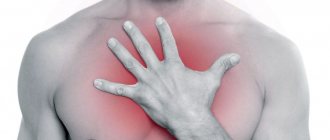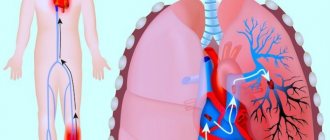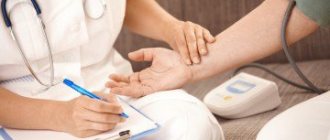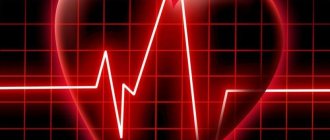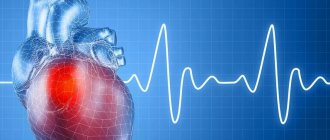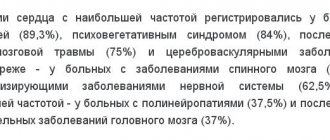Can there be arrhythmia and extrasystole of the heart with osteochondrosis?
Arrhythmia in osteochondrosis occurs when nerve endings and blood vessels are compressed by intervertebral discs.
The pathological condition can affect both the entire myocardium and some of its parts. Physiologically, this is manifested by extraordinary contractions of the heart muscle. Let us examine in more detail the reasons for the connection between the two pathologies, symptoms, types and methods of treatment... Arrhythmia in osteochondrosis occurs when nerve endings and blood vessels are compressed by intervertebral discs
What is osteochondrosis?
Osteochondrosis is the most commonly detected disease of the spinal column, which is a deformity of the spine. The danger of the disease lies in the fact that these processes last a long time and therefore are difficult to immediately detect. As a result, the spinal column is less flexible and more vulnerable.
The nerve endings and roots located in the spine are pinched, which creates severe and irrepressible pain.
Osteochondrosis is an extremely dangerous disease of the spine
There are three types of osteochondrosis:
- cervical (the most common);
- thoracic (the rarest type);
- lumbar (average in frequency of occurrence).
Osteochondrosis in the initial stages is detected due to symptoms hinting at a serious condition of the blood vessels.
This is the reason why doctors often diagnose “angina pectoris” or “vegetative-vascular dystonia” - that is, they call diseases of the cardiovascular system.
How does this happen? Now we'll tell you.
Why does it occur
Thoracic or cervical osteochondrosis and blood pressure can appear simultaneously due to compression of the vertebral artery. Blood accumulates in the heart; to push it through, the main muscle produces additional contractions, which is a violation.
Another cause of pathology is excessive load on the spinal column. Deformation of the discs appears, the anterior roots of which begin to be constantly irritated. This is a strong impulse for the central nervous system, which is “distracted” from controlling the work of the heart.
In some cases, heart rhythm disturbances may not occur due to osteochondrosis (although it is present in humans). Often both pathologies arise and are complicated:
- Cholecystitis.
- Inflammation of tissues.
- Nervous overload.
- Excessive physical activity.
By the way, there is also an inverse relationship: sometimes heart problems are caused by the development of osteochondrosis. This is especially true in the case of diseases in which the size of the heart muscle increases. This increases the load on the spinal column and provokes the development of serious diseases of the musculoskeletal system.
Clinical picture
Classification of pathology involves division into types of bone pathology and types of arrhythmia. In 80%, arrhythmia occurs with osteochondrosis of the thoracic spine, less often with osteochondrosis of the cervical spine. As you might guess, the division is based on the localization of the pathology.
Periodically occurring dizziness signals possible osteochondrosis
The arrhythmia itself can manifest itself in two forms: it can be tachycardia or extrasystole with osteochondrosis. In the first case, palpitations are observed when the heart contracts in the same rhythm, but more than 90 times per minute.
Extrasystole in osteochondrosis involves extraordinary, sudden contractions of the heart muscle.
Both types of arrhythmia, caused by pathologies in the spine, in addition to disruption of heart rhythm synchrony, may have the following symptoms:
- Feeling of tension and spasm in the area of the shoulder blades.
- Neuralgia (pain localized in the spine but echoing in the chest).
- Difficulty in inhaling (feeling as if there is not enough air).
- Semi-fainting, darkening of the eyes.
- Periodically occurring dizziness.
- Feeling of general weakness, increased anxiety.
- Osteochondrosis and arrhythmia can reduce the muscular ability of the limbs.
- Signs of vegetative-vascular dystonia (VSD), which may include impaired thermoregulation, sweating, gastrointestinal dysfunction, etc.
You should not think that tachycardia and extrasystole with osteochondrosis will appear immediately and in full force. Initially, rhythm disturbances make themselves felt in the form of short-term interruptions during increased physical activity. With such minor phenomena, as a rule, the patient does not think about the disease, believing that the arrhythmia or pain in the heart area is accidental and will soon go away on its own.
Types of arrhythmia and treatment
- Sinus type of arrhythmia - in this case, I diagnose an increase in the frequency of contractions of the heart muscle, from 90 or more beats per minute.
- Paroxysmal type of tachycardia. When this diagnosis is made, the heart works without pathological abnormalities, although its contraction frequency is increased - it is 140-240 beats per minute.
- Sinus type of bradycardia. In this case, the patient is diagnosed with a decrease in the frequency of contractions of the heart muscle and is no more than 55 beats per minute.
- Sinus type of arrhythmia - it is most often diagnosed in children and adolescents when the patient has an abnormal alternation of heart beats.
- Atrial fibrillation - in this case, the patient’s atria do not contract completely, and the frequency of contractions of the heart muscle gradually increases, reaching 300 beats per minute.
In terms of treatment, doctors, first of all, practice therapeutic methods of treatment that help eliminate the cause of heart rhythm disturbances and alleviate the patient’s general condition. But the patient should undergo a medical course of treatment, which includes taking certain medications.
When diagnosing cardiac arrhythmia, doctors use the following medications:
- Calcium and potassium channel blockers, as well as beta blockers.
- If the arrhythmia is accompanied by loss of consciousness, atropine or dopamine is prescribed.
- For gastric tachycardia, cordarone or lidocaine is prescribed.
If drug therapy does not provide positive treatment dynamics, doctors practice surgical intervention.
This method of treatment is radical and is used as a last resort.
- Radiofrequency testing - with the help of small punctures, arrhythmia can be completely eliminated. In this case, a special puncture is made in the muscle and the conducted impulse is blocked.
- Installation of a pacemaker - a special medical device that helps overcome arrhythmia of the heart muscle. Its main purpose is to maintain the normal heart rate at the proper level.
With osteochondrosis of the thoracic spine, as well as the cervical spine, 2 types of arrhythmias often develop:
- sinus tachycardia;
- extrasystole.
Heartbeat disturbances in osteochondrosis are constantly observed; they do not go away with rest. It becomes more pronounced when there is a load on the spine and a change in position to a more uncomfortable one, with sharp turns of the head. When the heartbeat is abnormal, sinus rhythm is always maintained.
Extrasystole occurs less frequently, because it appears in the very latest, advanced stages of osteochondrosis. This is an accelerated extraordinary contraction of the heart that follows a normal one, or several in a row. The pathology may not be felt or may be felt in the form of freezing, increased push behind the sternum. The pulse is weakened or its loss is noted. Rhythm disturbances are heard on auscultation.
If you start pathology
Many people believe that the arrhythmia that occurs with osteochondrosis is not dangerous. But not everything is so simple: often the patient ignores treatment of the underlying disease, directing all his efforts to suppressing various kinds of symptoms. As a result, the disease worsens, and a whole bunch of new problems are added to the disruption of the heart.
When a cardiac nerve is pinched, arrhythmia develops
If ventricular extrasystole or tachycardia is not eliminated in time, they can cause the following complications:
- The formation of blood clots, the rupture of which can have the most serious consequences for the patient’s life.
- Insufficient blood circulation to the brain, which increases the risk of strokes.
- The risk of sudden cardiac arrest with symptoms of clinical death increases.
Untreated osteochondrosis can be dangerous due to the following conditions:
- Cochleo-vestibular disorders, visual disorders.
- Bulging of the intervertebral disc.
- Protrusions and intervertebral hernias.
- Lumbago or sciatica.
- Prolapse of discs between the vertebrae.
- Spinosis of the spinal canal.
Appearing arrhythmia, and often pain in the heart area, are good reasons to consult a cardiologist and get an ECG. Holter ECG monitoring will give a more detailed result; in this case, it will be possible to determine exactly what cardiac arrhythmias there are and what kind of treatment is required.
Patient assistance
If ventricular extrasystole or tachycardia is mild, heart medications are usually not prescribed. In this case, it is determined why the connection between arrhythmia and osteochondrosis arose, and preventive measures are prescribed to combat bone pathology. This is often enough: as soon as osteochondrosis is eliminated, the arrhythmia will go away on its own.
Thoracic and cervical osteochondrosis can cause cardiac pathology
Complex treatment of the skeletal system may include the following procedures:
- A balanced diet that involves consuming foods high in magnesium and calcium.
- Therapeutic exercise, physiotherapy, manual therapy, osteopathy, used to eliminate reflex muscle complications.
- Ointments containing bee or snake venom, turpentine, tea tree oil. The use of warming external agents with an analgesic effect for cervical or thoracic osteochondrosis is exclusively anti-symptomatic (temporarily improves the condition, but does not eliminate the cause).
- Medicines to relieve tissue swelling (diuretic, sedative, anti-inflammatory).
- Drugs for correcting blood microcirculation and eliminating muscle spasms (for example, muscle relaxants).
Serious drug treatments for arrhythmia are indicated for moderate and high rates of heart rhythm disturbances.
In this case, in parallel with the measures described above for the treatment of the musculoskeletal system, the doctor may prescribe Pentoxifylline to restore normal blood supply to the brain, calcium channel blockers that affect the heart, and class 3 antirhythmics (Amiadoron, Amiacordin, Cardarone, Sotalex and others medications containing sotalol or amiadorone).
The connection between cardiac arrhythmia and osteochondrosis
One of the main signs of pathology of the musculoskeletal system is considered to be interruptions in the heart due to osteochondrosis. More than 60% of patients report such a negative manifestation. Arrhythmia often develops against the background of cervical osteochondrosis. This is due to the fact that, under the influence of dystrophic processes, the structure of the elements of the vertebral axis is disrupted, which leads to a change in the anatomical location of the vertebrae. As the pathology develops, this condition only gets worse. Displaced vertebrae put pressure on the base of the spinal artery and nerve fibers. In this case, there is a disruption in the supply of blood, oxygen and nutrients to the brain. Due to the narrowing of the lumen of blood vessels, oxygen starvation develops. The brain sends a signal to the heart, which begins to work more actively to compensate for the blood deficiency. Against this background, a rapid heartbeat occurs.
Long-term exposure to the pathological process on the myocardium can cause long-term interruptions in the functioning of the heart.
A similar situation is provoked by chondrosis of the thoracic spine. Infringement of the intercostal nerve endings leads to an impulse that is sent to the heart and manifests itself as pain, and can cause rhythm disturbances. Thoracic osteochondrosis also negatively affects the outflow of blood through large arteries due to deformation changes in the osteochondrosis tissue, which provokes frequent contractions of the myocardium.
Etiology and mechanism of development
Basically, arrhythmia in osteochondrosis occurs when exposed to the following negative factors that develop against the background of degenerative destruction of the spine:
- change in the natural position of the intervertebral discs;
- psycho-emotional experiences;
- increased loads on certain areas of the spinal axis;
- infringement of large arteries by deformed vertebrae.
The connection between chondrosis and heart rhythm disturbances is especially noticeable during the period of exacerbation of the underlying disease. Pathological changes in cartilage and bone tissue contribute to the development of arrhythmia. Due to the infringement of the main artery, the blood supply to the brain is disrupted, resulting in a jump in blood pressure. In order to eliminate dysfunction of the circulatory system, the heart begins to work several times faster, which is manifested by a violation of the rhythm and fullness of beats.
When arrhythmia occurs from osteochondrosis, the peculiarity of its course can be traced, which excludes heart pathologies:
- intensifies with active movements of the musculoskeletal system;
- has a continuous nature;
- beats occur according to sinus rhythm;
- accompanied by symptoms of osteochondrosis.
Return to contents
The effect of osteochondrosis on the heart
To eliminate arrhythmia, osteochondrosis must be effectively treated.
Today, various methods of treating spinal diseases are offered, among which conservative treatment is often used. At the first stage of its implementation, non-steroidal anti-inflammatory drugs are used. On the second, painkillers can be used, on the third, muscle relaxants can be used to help relieve muscle spasms. In the presence of extrasystole against the background of osteochondrosis, conservative treatment is allowed only with moderate and high severity of the pathology.
https://www.youtube.com/watch?v=OUR9iQplwpE
Physiotherapeutic procedures are an important part of the treatment of osteochondrosis and arrhythmia. They are often more beneficial for the spine than medications, but only physical procedures should be prescribed and carried out under medical supervision. If the condition is acceptable, massage and physical therapy can be performed, but even here it is important not to harm, which is why they should be done with the consent of the doctor.
It is important to remember that self-medication is unacceptable, as the condition may worsen. In particular, with self-reduction of intervertebral discs, persistent neuralgia and other disorders of the nervous system often develop. Also, hot baths and heating pads promote swelling of the intervertebral discs, which only intensifies the pain.
Doctors often encounter pain in the sternum even though the heart muscle is completely healthy. Their formation is associated with angina pectoris, however, during the examination no pathological changes are revealed, and taking medication that relieves heart pain has no effect.
Osteochondrosis can significantly affect the activity of the heart muscle and thereby provoke the occurrence of arrhythmia.
In this case, we can consider the effect of osteochondrosis on the heart, which has certain characteristic signs of the course of the disease. Initially, a somewhat rapid heartbeat occurs periodically and briefly, which manifests itself mainly after significant overexertion. If compression of the nerve endings in the sternum area occurs, the functioning of the heart muscle may deteriorate. Other reasons for a sudden increase in heart rate may include:
- nervous experiences;
- stress;
- cholecystitis;
- pneumonia.
That is why it is very important to recognize the true cause of heart problems, which will allow you to get rid of it much faster.
Osteochondrosis can significantly affect the activity of the heart muscle and thereby provoke the occurrence of arrhythmia. If the cardiac nerve is compressed, an arrhythmia occurs.
Interruptions in the heart with osteochondrosis of the cervical spine occur due to the fact that the vertebral artery is compressed. This vessel supplies blood to the brain tissue and with a lack of oxygen, hypoxia occurs. As a result of this, there is a disruption in the activity of some internal organs and various kinds of disturbances in the activity of the heart muscle.
Often, osteochondrosis extends to the area of the heart muscle and thereby provokes the occurrence of hypertension. That is why, in all patients with osteochondrosis, doctors additionally measure blood pressure. For many it turns out to be elevated.
Degenerative changes occurring in the spine often lead to hypertension. When pinching of the vertebral artery is added to the pathology, a crisis course of the pathology appears. In this case, blood pressure increases significantly and this can lead to interruptions in the functioning of the heart muscle.
If the pathology occurs in the thoracic spine, then there is a disruption in the functioning of many organs. In particular, many patients experience tachycardia, this is especially true for older people. The most characteristic signs indicating the presence of arrhythmia against the background of osteochondrosis may be the following:
- loss of consciousness;
- drowsiness;
- weakness.
To choose the best method of therapy, you must initially get rid of the main signs of osteochondrosis, and also monitor your blood pressure all the time.
It has long been proven that osteochondrosis affects the heart and provokes rapid heartbeat and arrhythmia. The vessels are compressed by vertebrae, muscle tissue or bone growths, which often leads to a slight increase in pressure.
A concomitant phenomenon and pathological condition determined against the background of the ongoing pathology is tachycardia. For normal blood microcirculation, the body needs to increase the heart rate, which manifests itself in the form of rapid heartbeat. Arrhythmia occurs when the heart cannot cope with the forced increased load.
When osteochondrosis occurs in the lumbar region, the adrenal glands begin to produce many chemicals that have a spasmodic effect on the vascular system. This condition provokes sudden changes and significant surges in pressure. That is why, we can say with complete confidence that no matter in which part of the spine the pathology occurs, in any case, it radiates to the heart.
Damage to the heart muscle is considered to be quite a dangerous complication, which is why therapy should be carried out at the initial stage.
https://www.youtube.com/watch?v=U8WmM8VEN6M
Doctors often have to deal with chest pain when the heart is completely healthy. Their appearance is primarily associated with myocardial infarction or angina pectoris. However, a cardiogram does not reveal pathological abnormalities, and auscultation and a number of other studies indicate a normal state of the heart, and taking cardiac medications does not relieve pain.
This disease is indeed often accompanied by cardiac pain syndrome, which occurs against the background of a completely healthy heart.
Heart pain may be a sign of osteochondrosis
Cardialgia can have a variety of clinical manifestations. The main symptom is the presence of pain in the heart. With osteochondrosis, they can arise and grow in paroxysms, although they are generally long-lasting and persistent. The sensations can be deep, boring or pressing, and are often accompanied by rapid heartbeat.
If heart pain occurs with cervical osteochondrosis, pain is often noted in the area of the spinous processes of the lower vertebrae of the neck. There may be a decrease in the strength of the muscles of the left hand, weakness of the little finger. Similar symptoms may occur with the cervicothoracic or thoracic form of the disease. The pain intensifies as a result of movement in the affected part of the spine, as well as when moving the arms.
With osteochondrosis, it is also possible to experience pain of a different nature in the heart area. For example, pain impulses can spread from the affected area to the muscles of the anterior chest, innervated by the V, VI, VII cervical roots. In such cases, pain is felt throughout the left upper quadrant of the body, including the chest, neck, left arm, and in some cases even part of the face.
Such pain can be quite long-lasting: it can last for several hours or even days. In this case, just as when the pain is localized only in the cardiac region, even at the peak of the attack no vascular disorders are recorded, the electrocardiogram does not reveal any abnormalities, and nitroglycerin and validol do not stop the attack.
Thoracic osteochondrosis causes heart pain
How exactly does osteochondrosis affect the heart? The mechanism of development of the pain syndrome is as follows: as a result of pathological deformation of the intervertebral discs, irritation of the anterior roots of the spinal cord occurs, causing pain impulses. They are sent to the heart, provoke excitation of the endings of the sensitive nerve roots, through which impulses are transmitted to the central nervous system. In it, impulses are perceived as painful sensations.
Evidence that pain in the heart region is a consequence of thoracic or cervical osteochondrosis is provided by the following data. When pain in the heart appeared, patients were injected with a solution of novocaine into the area of the VI, VII vertebrae of the cervical spine and I of the thoracic vertebrae. As a result, the pain disappeared. When administered distilled water, patients noted tingling in the chest.
Research results show: pain localized in the heart region with osteochondrosis can be reflected or occur only in the anterior surface of the chest, in the area of the projection of the heart. For this reason, heart pain has a dual development mechanism.
- There may be pain that is actually localized in the heart. Their occurrence is associated with the spread of pain impulses along the fibers of the autonomic nervous system from the nerve branches innervating the intervertebral discs and the vertebral body to the stellate ganglion, which provides sympathetic innervation of the heart muscle. In this case, cardialgia is associated with impaired innervation of the heart.
- Another mechanism for the development of heart pain is reflex. It is caused by a violation of the innervation of the tissues of the left arm and shoulder girdle in cervical and thoracic forms of osteochondrosis. The receptors of these areas do not receive a sufficient number of impulses, as a result they affect the autonomic parts of the nervous system associated with the innervation of the heart. Thus, in this case, cardialgia is of a reflex nature. This is confirmed by the fact that as a result of physical strain on the arm with impaired tissue innervation, pain appears in the heart area. However, the sensations are not limited only to the heart: they spread to the arm and the left upper quadrant of the body, can last from several hours to several days and are not accompanied by vascular disorders and changes in the ECG.
Clinical picture
The following symptoms are typical for arrhythmia attacks:
A sign of an arrhythmia attack may be a feeling of lack of air.
- pulling sensation between the shoulder blades;
- fainting state;
- feeling of lack of oxygen;
- darkening of the eyes;
- dizziness;
- decreased activity;
- pronounced weakness.
Similar symptoms in combination with back pain are observed when the thoracic region is affected, while osteochondrosis of the cervical spine can cause such types of arrhythmia as:
- Sinus tachycardia. It mainly develops during physical activity and is characterized by an increase in heart rate. With osteochondrosis, it occurs in a calm state. Accompanied by a burning sensation in the sternum and distinct heartbeats.
- Extrasystole. Occurs against the background of unstable contraction of the heart muscle during physical exertion. Symptoms are mild, so the pathological condition is determined through clinical studies.
Return to contents
Symptoms
Interruptions in the functioning of the heart that occur against the background of osteochondrosis are a completely understandable phenomenon, resulting from pinching of nerve endings and squeezing of large blood vessels. In this case, the patient may notice disturbances in heart rhythm and a significant deterioration in well-being. In addition, many other symptoms occur, including:
- feeling of fluttering in the chest;
- dyspnea;
- chest pain;
- fainting;
- dizziness.
Whether arrhythmia could be due to osteochondrosis can only be determined by the attending doctor after a thorough comprehensive examination. Many doctors believe that if osteochondrosis provokes the occurrence of arrhythmia, then this does not pose a serious threat to the patient’s health. That is why, in order to eliminate the pathology, it is necessary to initially treat disorders of the musculoskeletal system and only after that do a repeat cardiogram. After treatment for osteochondrosis, heart problems should also go away.
Since various heart diseases are quite often observed in osteochondrosis, it is necessary to carry out complex therapy, since in advanced cases pathological disorders of the cardiovascular system can form, namely such as:
- ischemic disease;
- stroke;
- heart attack
To prevent complications from occurring, you need to consult a doctor in a timely manner and it is advisable to undergo examination by several specialists.
More often, symptoms of arrhythmia, manifested in various forms, can be caused by thoracic osteochondrosis, less often by cervical osteochondrosis. Symptoms of the pathology are usually accompanied by dizziness that occurs from time to time.
Arrhythmia will also cause:
- slight pain between the shoulder blades, which can be described as tension;
- feeling of lack of air when inhaling;
- general weakness, sweating, hot flashes, bluish lips, pale skin;
- paroxysmal darkening of the eyes;
- fainting states;
- tremors in the chest with a feeling of freezing of an important organ or similar to a revolution;
- anxiety.
Muscle ability in the left hand may decrease, and numbness may appear in the fingers. During chest thrusts, pain can be observed in the shoulder, neck, and lower face. This condition can last for several hours or days. Detecting heart pathology using hardware methods and taking medications does not give any results.
Other characteristic signs of osteochondrosis, which causes arrhythmia, include pain that occurs:
- when moving your head;
- in a horizontal position of the body;
- at night.
Typically, arrhythmia occurs against the background of damage to the thoracic or cervical spine. Problems with heartbeat are rarely associated with pathology of the lumbar spine.
Against the background of physical activity that aggravates osteochondrosis, extrasystole may develop. This type of arrhythmia manifests itself:
- sleep disorders;
- dizziness;
- anxiety;
- increasing weakness;
- increased sweating;
- a feeling of increased rhythm or freezing of the myocardium.
It is important not only to determine arrhythmia, but also to identify its connection with osteochondrosis. The following signs indicate its presence:
- the attack is not stopped by Nitroglycerin;
- heart rate does not change when walking;
- heartbeat disturbances are accompanied by pain characteristic of osteochondrosis;
- the condition is aggravated by stress on the spine;
- the condition is normalized after the symptoms of osteochondrosis are relieved with medications (antispasmodics, anti-inflammatory drugs, drugs that improve blood circulation).
Only a specialist can determine that arrhythmia is associated with osteochondrosis. To do this, it is necessary to conduct a general examination, collect anamnesis and prescribe some studies.
Diagnostics
To determine the root cause of changes in heart rhythm, the doctor collects a history of complaints and related ailments. Next, the heart is listened to, pulse and blood pressure are measured. If it is suspected that arrhythmia is a complication of osteochondrosis, the following studies are carried out:
For a complete examination, the patient must undergo a cardiogram.
- Cardiography. Determines pathological changes in the rhythm of heart beats.
- Ultrasound of the heart. Diagnoses structural changes in all elements of the cardiac system.
- X-ray. Determines the size and position of the heart, as well as the presence of focal formations in the spine.
- MRI and CT. Minimum structural disturbances in bone and cartilage tissue are established.
Return to contents
Treatment options
First of all, therapy is aimed at eliminating the underlying disease. To relieve pain in osteochondrosis, non-steroidal anti-inflammatory drugs are used. In order to reduce the severity of inflammation, chondroprotectors and glucocorticoids are used. Vitamin and mineral complexes are widely used. To eliminate negative symptoms in the form of arrhythmia, sedatives and diuretics are prescribed.
Means of physical rehabilitation, such as massage, physiotherapy and exercise therapy, can improve the patient’s well-being. Massage movements improve blood flow and promote muscle relaxation. Physiotherapeutic procedures have an analgesic effect, activate microcirculation and stabilize trophic processes. As a rule, medicinal electrophoresis and balneological procedures are used. Exercise therapy is aimed at normalizing blood circulation and accelerating the removal of decay products from the body. Particular attention is paid to diet. Avoid eating fatty and heavy foods.
The nature of the relationship
The seemingly inconsistency in detecting arrhythmias of different types (tachycardia, bradycardia and atrial fibrillation) against the background of existing spinal lesions can be explained quite simply: any changes in the condition of the vertebrae and spinal discs, which can provoke a disturbance in the conductivity of nervous tissue, compression of the nerves between the changed vertebrae and the degree worn out discs lead to the formation of severe pain in the chest area. It is this manifestation that is considered the most common when arrhythmia is detected in osteochondrosis.
Since the lifestyle of a modern person is characterized by a reduced amount of physical activity with a predominantly sedentary lifestyle, osteochondrosis and arrhythmia, which are closely related to each other, tend to appear almost simultaneously. Osteochondrosis, which manifests itself in the thoracic spine, is today considered one of the most common types of lesions of the spinal column, which entails pain in the heart area.
By pinching the nerve endings, the vertebrae become deformed over time with little activity. Their irregular shape not only provokes the occurrence of pinched nerves, but also entails a decrease in the degree of conductivity of the nervous tissue. This negatively affects the functioning of the entire body and can cause a number of organic disorders.
Advanced stages of osteochondrosis have a sharply negative effect on most organs and systems. And answering the question whether osteochondrosis can cause arrhythmia, it should be understood that the dependence of the work of the heart and its general condition on the health of the spine is manifested in the physically close location of these organs, the abundant penetration of blood vessels between the vertebrae and spinal discs.
Results
Arrhythmia in osteochondrosis of the thoracic spine is quite common. If a patient feels the first signs of arrhythmia, he should immediately consult with his doctor.
Arrhythmia requires an integrated approach to treatment, where all efforts are aimed at getting rid of the root cause - osteochondrosis.
Arrhythmia in osteochondrosis of the thoracic spine is curable if everything is done correctly and on time
Following your doctor’s recommendations, including attending procedures and leading an active lifestyle, helps you quickly get rid of pain and attacks. Try not to waste time on self-medication, so as not to make your body worse.
Reasons for the development of arrhythmia in osteochondrosis
Osteochondrosis and cardiac arrhythmia are physiologically related, because the heart muscle is located in close proximity to the spinal column. Any type of arrhythmia is caused by lesions of blood vessels, which are subject to significant stress when they are compressed while passing through the spine.
Severe disturbances in the functioning of the cardiac system, manifested in the form of a deterioration in the process of pumping the entire volume of blood by the heart muscle, can be provoked by the following reasons:
- compression of blood vessels passing through the spinal column. At the same time, there is a decrease in their lumen, as a result of which the rate of blood passage into tissues and organs, which begin to receive less of the required amount of nutrients and oxygen, sharply decreases;
- increasing the amount of load on the spine, which, despite its significant volume, reduces the degree of functionality of the spine;
- when spinal discs prolapse or become deformed, there is a high probability of pinching of nerve endings, of which there are a large number in this area. This is especially true for the thoracic spine.
The listed reasons can have multiple consequences, expressed in significant symptoms of arrhythmia. However, there are frequent cases when healthy people without visible pathology in the circulatory system experience a significant deterioration in the functioning of the circulatory system and blood vessels, which manifests itself primarily in changes in the rhythm of heart contraction (arrhythmia). Even a minor stage of current spinal pathology can cause such painful sensations, so timely detection of it will help not only eliminate pain in the heart area, but also maintain its health.
Diagnosis of this cardiac pathology most often occurs with pathologies that arise in the cervical or thoracic spine. Pain can have a very different character, degree of manifestation and duration, but all these symptoms should be considered manifestations that need to be studied: after all, both the speed of healing and the maintenance of the positive results largely depend on early diagnosis.
Diagnosis and treatment of cardialgia in osteochondrosis
Traditional medicine also has in its arsenal many recipes for combating arrhythmia - this is the help of medicinal herbs and mixtures.
An infusion of pansies gives an excellent result - just steam 2 tsp in a glass of boiling water. dried color and leave for about 2-3 hours. Take 1-2 tbsp 3-5 times throughout the day. l.
Oxalis, or more precisely, its inflorescences, also shows good treatment results - a tablespoon of dried raw material is steamed in a glass of boiling water and left for an hour. Allow to cool to room temperature and drink as tea.
Asparagus is not just a side dish, but also a medicinal plant. Not only young shoots are taken as medicine, but also the rhizome - they are finely chopped and steamed in boiling water. Infuse for 2-3 hours and, after straining, drink in small sips throughout the day - the maximum dosage is no more than a glass per day.
Fragrant celery 500 gr., 50 gr. parsley and 30 grams of propolis - the mixture is steamed with 2 liters of boiling water and left for 24 hours. Take this infusion - no more than a glass a day.
Medicinal mixtures
Combination of onion and apple. Take 1 pc. apples and onions, peel and chop, mix with each other - take 1 tsp of this mixture. twice a day for a month.
Salad – celery and parsley, dill and sour cream. Tasty and simple - it contains a lot of useful vitamins that strengthen the heart.
Juices are also an excellent remedy for treating arrhythmia, especially if you combine several types of them in one glass. A mixture of beet, radish and carrot juices in equal proportions helps restore normal heart function.
Dried fruits – 200 gr. dried apricots, raisins and walnuts, which are poured with 200 ml of liquid honey and the juice of 1-2 lemons is added. Mix everything and store it in the refrigerator - take a tablespoon after meals three times a day.
Be sure to read:
Main causes and symptoms of hypotension: treatment with folk remedies
Without a full examination, it is impossible to treat with antihypertensive drugs, because in case of osteochondrosis they will not give an effect, but the development of addiction to them in the future will complicate treatment.
You cannot treat the heart with osteochondrosis by applying heating pads, visiting steam rooms and saunas: heat will contribute to the development of swelling of the tissues around the disc and even greater infringement of the roots in the spine. A new attack will be provoked.
A general back massage is unacceptable, since it only helps to relax the superficial muscles. It simply does not reach the deep muscles of the back, and these are the ones that need to be relaxed, they surround the vertebrae and discs.
Symptoms of pain are well relieved with analgesics, but they do not eliminate the cause of the disease.
Only a specialist can prescribe therapeutic measures, taking into account the type of disease and how severe it is. Self-prescribing any treatment for arrhythmia is extremely dangerous; the consequences can be fatal.
Therapeutic measures are based on measures aimed at reducing the symptoms of the disease, increasing survival in certain periods, eliminating the consequences and possible complications. Treatment can include both medications and surgery.
To select the most effective therapy, it is very important to identify and eliminate the causes of the development of this pathology.
Medicines for the treatment of arrhythmia are divided into three types: drugs that cope with the atrial type of disease, aimed at treating ventricular disorders, and a universal group that affects both types of disease. Arrhythmia is treated through surgery only if the patient has other diseases of the cardiovascular system.
Symptoms
Any disease of the spine that will cause disturbances in heart rhythm and the degree of myocardial functionality must be detected in a timely manner; this will help prevent the pathology from worsening, relieve pain and eliminate the causes that caused the underlying disease (osteochondrosis) and its consequences (arrhythmia and cardiac dysfunction).
The most characteristic symptoms of arrhythmia, which develops in the presence of any stage of osteochondrosis, include the following manifestations:
- the appearance of pain in the heart area, which can vary significantly in nature and manifestations: they can be sharp, pulling, short in the form of jolts and in the form of attacks that can last for different times (from several minutes to a day);
- pain from the heart area can even extend to the arm, shoulder and forearm;
- in the right hand there is likely to be a decrease in sensation, a decrease in the degree of its performance.
It should be noted that in case of arrhythmia, accompanied by severe pain, which occurs in the presence of any stage of osteochondrosis, taking medications that should reduce the manifestation of pain, as a rule, does not bring visible relief to the patient.
In the presence of damage to the cardiac system such as hypertension, osteochondrosis increases the degree of manifestation of symptoms. By aggravating this disease, osteochondrosis also stimulates a longer persistence of elevated blood pressure. This is especially dangerous in case of weakness of the heart muscles, since it often provokes a pre-infarction state.
Osteochondrosis as a cause of arrhythmia
Often, upon initial detection of one or another type of arrhythmia in a patient who has consulted a therapist or cardiologist, upon detailed examination he is diagnosed with degenerative-dystrophic changes in the spine, the so-called osteochondrosis.
At an appointment with a specialist, in the absence of direct causes causing arrhythmia, for example, post-infarction cardiosclerosis, the doctor is faced with the task of determining whether problems associated with heart rhythm could be a consequence of osteochondrosis?
The reason for the relationship between arrhythmia and osteochondrosis
From spinal roots damaged at any level, pathological impulses go to various internal organs, including the heart. In this case, various types of arrhythmias may occur, but the most common of them are extrasystole (extraordinary irregular heartbeat) or sinus tachycardia (rhythmic rapid heartbeat).
Pathological changes in the bone and cartilaginous structure of the spinal column increase gradually, over the years, people live almost without noticing them until the nerve structures located paravertebral (that is, next to the spine) are involved in the process. The development of arrhythmia may be due to a number of factors:
- Neurogenic cause - excessive overstimulation of the spinal roots due to their compression leads to the appearance of a pathological impulse in the central nervous system, which then transmits pathological signals to the heart.
- Vascular cause - the myocardium of the left ventricle of the heart experiences excessive load due to an increase in the volume of blood coming from the vascular bed of the vertebral artery, a large vessel located in close proximity to the spinal column. The blood flow in this artery is disrupted due to its compression in the cervical or thoracic spine, and the heart muscle reacts by increasing the number of contractions.
The main complaints made by patients with arrhythmia manifested as a result of osteochondrosis
- Physical activity does not precede an attack of arrhythmia;
- Prolonged vertical load on the spine, especially in its cervical or thoracic region, provokes an attack of arrhythmia;
- Extraordinary contractions of the heart, episodic or constant, are felt by patients themselves as a feeling of “interruptions” in the work of the heart;
- Stitching, burning pain behind the sternum;
- Psychogenic disorders may be observed on the part of the nervous system: increased anxiety, fear, restlessness.
- Manifestations from the autonomic nervous system: sweating, chills, functional digestive disorders.
- From the musculoskeletal system: pain in the spine, stiffness in the movements of the limbs and back, muscle spasm.
Treatment
Therapeutic measures are aimed at influencing the affected area of the spinal column in order to eliminate the primary source of the pathological process. The main directions of therapy include the following principles:
- Immobilization of the body in the area of the affected spine. Thus, a Shants collar is used to fix the cervical spine, and a tight bandage is used for the thoracic spine. A prerequisite is that the patient is lying on a hard surface.
- Skeletal traction of the spine is used to eliminate compression from pathologically altered vertebral bodies on intervertebral cartilaginous discs, as well as spinal roots and nearby blood vessels.
- Physiotherapeutic methods are aimed at eliminating pain and gently restoring the motor function of the spine. Main methods: magnetic therapy (can be used in the acute phase of inflammation), electrophoresis with various medications, spinal massage, acupuncture, balneotherapy.
- Pharmacotherapy: a number of medications are used, strictly as prescribed by the doctor.
Prevention
Preventive measures are aimed at a rational regime of work and rest without prolonged static loads on the spine.
Mechanism of development of osteochondrosis
At a young age, with any load on the spine, it is compensated by the intervertebral disc. In this case it works as a shock absorber. Over time, for various reasons, the discs wear out: their blood supply gradually deteriorates due to a decrease in the number of vessels, while the disc gradually shrinks.
Cracks appear on its surface, they widen and deepen, and the protective fibrous ring of the disc breaks. The disc pulp bulges and an intervertebral hernia develops. Adjacent vertebrae begin to fuse compensatoryly. They fuse with the discs, limiting the mobility of the spinal column. Spondylosis forms, which is the next stage of osteochondrosis.
In this way, the body tries to reduce pain and slow down the process of degeneration. During these processes, the discs begin to thin out (disc protrusion). In addition, even small loads already cause pain in the spine and endurance decreases. Episodic at first, they later become permanent. Moreover, pain appears not only in the heart, but osteochondrosis and tachycardia are necessarily interconnected.
Does osteochondrosis affect the appearance of heart pain and why? The clear answer is yes. The main cause is compression of the vertebral or vertebral artery, which runs along the entire spine and cardiac nerve. The vertebral artery supplies blood to 25% of brain cells.
In addition, cerebral ischemia develops, i.e. hypoxia, causing spasm of blood vessels and muscles. Because of this, the central innervation of internal organs, including the heart, is disrupted. Thus, a disturbance of cardiac activity occurs with interruptions in rhythm.
The paravertebral tissues become inflamed, the anterior root nerve endings of the spinal cord are irritated. And if these endings innervate the heart, they can cause arrhythmia. Everything is very clearly interconnected. The number of impulses from the endings during inflammatory reactions increases and a zone of pathological impulses appears in addition to the normally functioning sinus node. In this case, the heartbeat with osteochondrosis with its frequency, rhythm and a certain sequence of contractions is disrupted.
Arrhythmias often occur with poor posture:
- scoliosis;
- stoop as a result of physical inactivity;
- long-term monotonous loads;
- sitting in an awkward position.
When such interruptions occur, it is not the heart that is treated, but the spine. Arrhythmias in osteochondrosis differ in some manifestations.
At a young age, with any load on the spine, it is compensated by the intervertebral disc. In this case it works as a shock absorber. Over time, for various reasons, the discs wear out: their blood supply gradually deteriorates due to a decrease in the number of vessels, while the disc gradually shrinks.
Spondylosis forms, which is the next stage of osteochondrosis.
In this way, the body tries to reduce pain and slow down the process of degeneration. During these processes, the discs begin to thin out (disc protrusion).
Moreover, pain appears not only in the heart, but osteochondrosis and tachycardia are necessarily interconnected.
Symptoms of osteochondrosis are determined by damage to a certain part of the spine: cervical, thoracic, lumbar. With cervical osteochondrosis, migraine headaches often occur, especially in the back of the head, pain in the neck and collar area.
When moving the head, dizziness, pre-syncope, and even loss of consciousness appear. Tachycardia with osteochondrosis of the cervical spine is always accompanied by cephalgia, especially in the morning.
Characteristic is the appearance of pain in the lower vertebrae of the neck with osteochondrosis of the cervical spine.
Thoracic osteochondrosis more often causes heart failure than other parts. With it, scoliosis and curvature of posture often develop.
Lumbar osteochondrosis can also be the cause of tachycardia, but the mechanism here is somewhat different: when the nerve endings are irritated, the adrenal cortex is involved in the process, which then begins to secrete an increased amount of a substance that provokes vasospasm (catecholamines). Because of them, changes in blood pressure and increased heart rate appear.
Reviews from our patients
I would like to thank Dr. Skoritchenko A.A. for your attentive and professional attitude. He literally put me back on my feet and relieved me of long and painful back pain. Thank you very much and bow to him. Shcheglova Tatyana Vasilievna.
After a difficult birth of my wife (hypoxia in the baby), the neurologist advised me to contact Dr. Zhanna Nikolaevna Balabanova (clinic in Mitino). After the first 2 sessions, the baby showed noticeable improvements, and at the age of one year, the neurologist noted that the child did not have a single deviation. We are grateful to Zhanna Nikolaevna for her.
I would like to say a big thank you to Dr. Dmitry Anatolyevich Toroptsev and massage therapist Ruslan Khaidarovich Iksanov, these are highly professional people. I'm still in the middle of my journey, but the effect of the treatment is already noticeable. In the clinic on Malomoskovskaya near the station. m. Alekseevskaya warm and cozy atmosphere and what else.
I thank Doctor Khalili Ramazan Nusretovich for his high professionalism and kindness! This is our family Doctor for several months now. My husband suffered from back and shoulder pain for several years. I endured it. Until I stopped sleeping because of the pain. After several sessions with the Doctor, the pain subsided and the condition improved.
